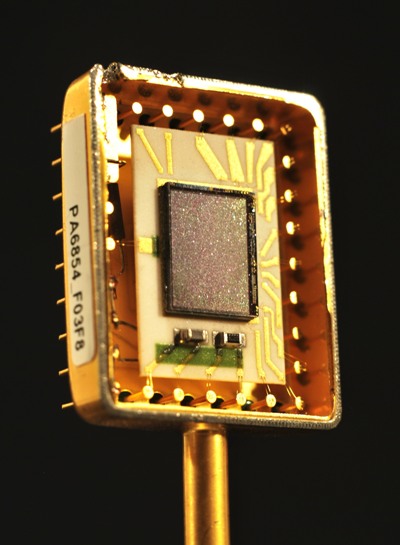Supplement 1.8: Radiation detectors (1/5)
Thermal detectors
Bolometers
The bolometer is a resistance thermometer. The change in temperature caused by heat results in a change in electrical resistance. In its original version, the sensor consists of a metallic wire or strip made of platinum due to its easily reproducible resistance changes. As with any detector, the sensitivity, i.e. the relationship between absorbed optical power and generated electrical signal, must be known or determined by calibration. Bolometers have a very broad and flat spectral sensitivity and are suitable for the visible and infrared ranges up to the microwave range. They can be used to measure constant and variable radiation, e.g. pulsed radiation.
Recent developments utilise semiconductors whose electrical resistance changes much more significantly than that of metals. Since the 1980s, microbolometers measuring approximately 12 μm have been available for use as elements in arrays in thermal imaging cameras. Here, sensitivity depends on the semiconductor used and is often limited to specific spectral ranges using optical filters.

Pyroelectric detectors
The sensor of a pyroelectric detector consists of a pyroelectric crystal that is only a few micrometres thick and generates an electrical voltage on two opposite surfaces when the temperature changes. The voltage is tapped with electrodes. Since only temperature changes generate such voltages, it is suitable for measuring pulsed radiation with pulse repetition rates up to several kHz, but not for constant radiation. These detectors are also used for motion detectors, which are designed to detect moving persons, i.e. changing temperatures.
The detector shown above has a 2,7×2,7 mm² lithium tantalate sensor integrated into a transistor housing with a diameter of 9,2 mm. Its spectral sensitivity ranges from 100 nm to 1000 μm. It is used to monitor the power of pulsed lasers, a very small portion of whose radiation is directed onto the detector by a beam splitter.
Thermoelectric detectors
For higher laser powers, there are detectors that utilise the thermoelectric effect, also known as the Seebeck effect. Here, two wires or plates made of different metals, such as copper and iron, are connected. When the contact point and the non-contact sides are at different temperatures, a thermoelectric voltage is generated. Several such arrangements can be cascaded into a thermopile to amplify the effect. The suitability for high laser powers results from the better thermal resilience of the comparatively larger metal components that make up the sensor. These detectors are suitable for measuring constant and pulsed radiation.
The reverse effect is known as the Peltier effect: in Peltier elements, a temperature difference is generated using an electric current in order to achieve cooling or heating.
Die aktive Fläche des hier gezeigten Detektors, erkennbar durch einen Ring, hat 25 mm Durchmesser. Er eignet sich für Pulsenergien bis zu einigen Joule. Seine geschwärzte Fläche hat durch hohe auftreffende Laserleistung bereits etwas gelitten.
